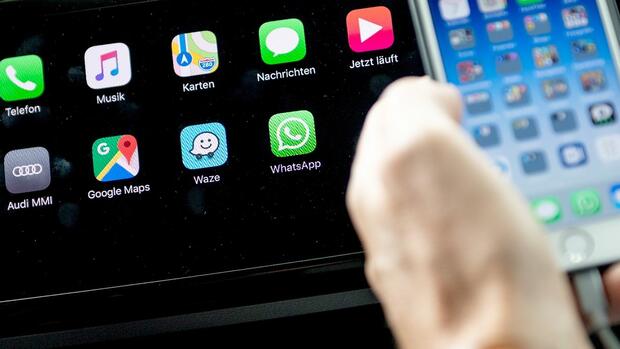![]()
Munich “In the best case, this works automatically and the user does not even notice that the smartphone connects to the entertainment system of the car. This means that access to the content is available and you can use the device immediately,” says Timo Brauer from the technology portal “Inside- digital.de “. This can work in different ways. “The simple Bluetooth connection allows you to make calls and listen to music, and the SMS function can also be used,” explains Brauer.
However, if you want to use more smartphone functions, you have to establish a connection via Android Auto or Apple Carplay wirelessly or via cable, depending on the mobile phone operating system. Meanwhile, most modern cars offer these two interfaces.
Restriction vs. distraction
“The basic idea with Apple Carplay and Android Auto is to mirror certain functions or apps onto the vehicle display – even with a limited amount of information so as not to distract the driver,” explains Hannes Rügheimer from the trade magazine “connect”. This included, for example, music playback or navigation.
However, the controls are greatly reduced compared to the display on the smartphone display. With Whatsapp or iMessage, for example, you only receive an information that a new message has arrived. “The news content itself can only be read aloud, but not read on the vehicle display itself,” says Rügheimer. Safe is safe.
Top Jobs of the day
Find the best jobs now and
be notified by e-mail.
Whether the interaction between smartphone and Apple Carplay or Android Auto works wirelessly or wired usually depends on the age of the vehicle. “New vehicle models usually support both variants, but for slightly older ones until about 2019, only the USB variant usually works,” explains Rügheimer.
Although there are also accessory solutions through which an actually wired connection can be converted wirelessly with the help of an adapter. “However, this also requires a little tinkering and skill,” says Hannes Rügheimer.
Some manufacturers do not participate
For some vehicle manufacturers, this does not help. “The Tesla system, for example, does not support Apple Carplay or Android Auto, here you can only connect your smartphone to the car via Bluetooth to use the phone functions,” says Timo Brauer.
If you are traveling with an older car with a classic car radio, you have the opportunity to replace the installed device. A modern media receiver for the car is available from around 300 euros. “Alternatively, you can also attach an external display with Carplay and Android Auto to the windshield or dashboard,” explains Brauer. However, this always involves cables, for example for the power supply.
Another possible variant is to place the smartphone in a suitable holder in the field of view. Hannes Rügheimer advises against it. “On the one hand, the risk of distraction is great and in addition, any physical interaction, such as tapping the display, is illegal. In the case of a police check, this results in a penalty and points in Flensburg.”
The German Road Safety Council (DVR) also warns of the distraction caused by the smartphone in the car. The risk of accidents when making calls at the wheel increases by two to five times, according to the DVR. Although it is not forbidden to make calls via a hands-free system, this is a not inconsiderable distraction.
Voice control for safe operation
In order to keep the distraction as low as possible, on the one hand, most systems can now be operated via voice control. In addition, Apple Carplay and Android Auto severely limit the number of apps. “Apple and Google check every single app plus the concrete implementation before they release access to the car display,” says Hannes Rügheimer. For example, music streaming is possible, but TV or video streaming is not.
One reason why the selection of apps for Apple Carplay and Android Auto is relatively small is also due to the development effort. “The respective developer must offer a very special view for the two systems for his app and adhere to the specifications of Apple and Google,” says Brauer.
However, it is still possible to play smartphone videos, for example, if the mobile phone is connected to the car via a pure mirroring function from the accessories. “It would be sensible and also legal if the vehicle is stationary. This could, for example, bridge the charging time for an electric car,” says Rügheimer. For example, Tesla also operates in this way, where the video function of the entertainment system is enabled in the parking position.
Functional duplications rather than functional losses
By the way, if you use Apple Carplay or Android Auto, you don’t have to worry that this will turn off functions of the integrated entertainment system. “It is rather the case that there are then functional duplications. If, for example, the built-in system has navigation, then Google Maps or Apple maps will be added,” explains Rügheimer.
In some vehicle systems, however, there are now also so-called crossover functions, which “connect” also tests again and again: “It is then possible, for example, to keep the car radio running in the background while the navigation on the screen comes from a smartphone.”








